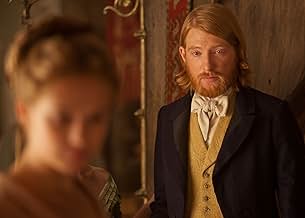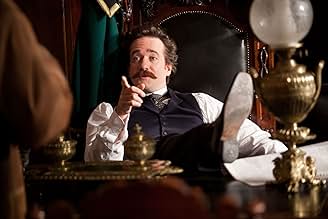Nella Russia del 19esimo secolo, l'aristocratica di San Pietroburgo Anna Karenina intraprende una relazione con l'affascinante conte Alexei Vronsky.Nella Russia del 19esimo secolo, l'aristocratica di San Pietroburgo Anna Karenina intraprende una relazione con l'affascinante conte Alexei Vronsky.Nella Russia del 19esimo secolo, l'aristocratica di San Pietroburgo Anna Karenina intraprende una relazione con l'affascinante conte Alexei Vronsky.
- Vincitore di 1 Oscar
- 33 vittorie e 54 candidature totali
Trama
Lo sapevi?
- QuizOne of Alicia Vikander's favorite experiences from the production was the filming that took place in the countryside outside of St. Petersburg, Russia. The temperatures dropped below -40 °C, and she stayed in a cabin for five days that didn't have hot water and only featured benches instead of beds. Meanwhile, Russian security guards protected her and co-star 'Domhnall Gleeson' from wild wolves and bears that dominated the deserted area.
- BlooperThe label of the bottle of morphine Anna drinks from changes from "la Morphine" to "Morphine" between shots. The only correct French form would be without an article (prescriptions would have been written in Latin in 19th-century Russia anyway).
- ConnessioniFeatured in Projector: Anna Karenina (2012)
- Colonne sonoreSong for a New Life (Masha's Song)
(uncredited)
Written by Anoushka Shankar
Performed by Tannishtha Chatterjee
Recensione in evidenza
It took me about an hour to stop being irritated by the movie's self consciousness, to sort of enjoy it... but the damage was done.
As viewers, we have no reason to believe in the love Anna finds. He is creepy and give us no inkling of why she might ruin her life for him.
Kiera isn't bad, just annoying, considering we have no empathy for her self indulgence. If her husband was worse, her love a lot nicer, and if we could feel electricity between them, it would be a different matter, but the fact is the movie is too busy being clever... it misses out on having a heart and soul.
The theatre gimmick got in the way, and seemed like a cheap way of having Moscow backdrops without actually traveling there.
5/10
As viewers, we have no reason to believe in the love Anna finds. He is creepy and give us no inkling of why she might ruin her life for him.
Kiera isn't bad, just annoying, considering we have no empathy for her self indulgence. If her husband was worse, her love a lot nicer, and if we could feel electricity between them, it would be a different matter, but the fact is the movie is too busy being clever... it misses out on having a heart and soul.
The theatre gimmick got in the way, and seemed like a cheap way of having Moscow backdrops without actually traveling there.
5/10
- mark-palmos
- 6 set 2012
- Permalink
I più visti
Accedi per valutare e creare un elenco di titoli salvati per ottenere consigli personalizzati
- How long is Anna Karenina?Powered by Alexa
Dettagli
- Data di uscita
- Paesi di origine
- Sito ufficiale
- Lingua
- Celebre anche come
- Chuyện Tình Anna
- Luoghi delle riprese
- Kizhi, Karelia, Russia(on location)
- Aziende produttrici
- Vedi altri crediti dell’azienda su IMDbPro
Botteghino
- Budget
- 40.600.000 USD (previsto)
- Lordo Stati Uniti e Canada
- 12.816.367 USD
- Fine settimana di apertura Stati Uniti e Canada
- 320.690 USD
- 18 nov 2012
- Lordo in tutto il mondo
- 68.929.150 USD
- Tempo di esecuzione2 ore 9 minuti
- Colore
- Mix di suoni
- Proporzioni
- 2.35 : 1
Contribuisci a questa pagina
Suggerisci una modifica o aggiungi i contenuti mancanti

































